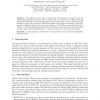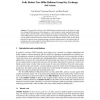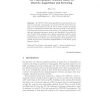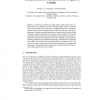130
click to vote
CANS
2009
Springer
14 years 10 months ago
2009
Springer
Group signatures allow users to anonymously sign messages in the name of a group. Membership revocation has always been a critical issue in such systems. In 2004, Boneh and Shacham...
113
click to vote
CANS
2009
Springer
15 years 4 months ago
2009
Springer
We extend the well-known Tree-Diffie-Hellman technique used for the design of group key exchange (GKE) protocols with robustness, i.e. with resistance to faults resulting from poss...
110
Voted
CANS
2009
Springer
15 years 7 months ago
2009
Springer
We present a hash-based signature scheme customized for wireless sensor networks. For message lengths required by instructions or queries from the base station or single measuremen...
92
Voted
CANS
2009
Springer
15 years 7 months ago
2009
Springer
We propose an efficient blind certification protocol with interesting properties. It falls in the Groth-Sahai framework for witness-indistinguishable proofs, thus extended to a ce...
101
Voted
CANS
2009
Springer
15 years 7 months ago
2009
Springer
In this paper, we study the broadcast authentication problem for both erasure and adversarial networks. Two important concerns for authentication protocols are the authentication ...
116
Voted
CANS
2009
Springer
15 years 7 months ago
2009
Springer
Abstract. Wireless sensor networks have several useful applications in commercial and defense settings, as well as user-centric personal area networks. To establish secure (point-t...
99
Voted
CANS
2009
Springer
15 years 7 months ago
2009
Springer
Abstract. At CRYPTO 2003, Rubin and Silverberg introduced the concept of torus-based cryptography over a finite field. We extend their setting to the ring of integers modulo N. W...
109
Voted
CANS
2009
Springer
15 years 7 months ago
2009
Springer
Abstract. Anonymous credentials are widely used to certify properties of a credential owner or to support the owner to demand valuable services, while hiding the user’s identity ...
102
Voted
CANS
2009
Springer
15 years 7 months ago
2009
Springer
Abstract. We consider generic Garbled Circuit (GC)-based techniques for Secure Function Evaluation (SFE) in the semi-honest model. We describe efficient GC constructions for additi...
CANS
2009
Springer
15 years 7 months ago
2009
Springer
When users wish to establish wireless communication between their devices, the channel needs to be bootstrapped first. Usually, the channel is desired to be authenticated and con�...




